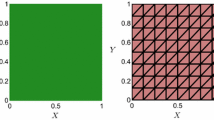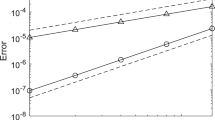Abstract
In this paper, we develop an adaptive finite element method for the nonlinear steady-state Poisson-Nernst-Planck equations, where the spatial adaptivity for geometrical singularities and boundary layer effects are mainly considered. As a key contribution, the steady-state Poisson-Nernst-Planck equations are studied systematically and rigorous analysis for a residual-based a posteriori error estimate of the nonlinear system is presented. With the regularity of the linearized system derived by taking G-derivatives of the nonlinear system, we show the robust relationship between the error of solution and the a posteriori error estimator. Numerical experiments are given to validate the efficiency of the a posteriori error estimator and demonstrate the expected rate of convergence. In further tests, adaptive mesh refinements for geometrical singularities and boundary layer effects are successfully observed.
Similar content being viewed by others
References
Adams, R.A.: Sobolev Spaces. Academic Press, New York (1975)
Ainsworth, M., Babuška, I.: Reliable and robust a posteriori error estimation for singularly perturbed reaction-diffusion problems. SIAM J. Numer. Anal. 36(2), 331–353 (1999)
Ainsworth, M., Oden, J.T.: A posteriori error estimation in finite element analysis. Wiley, New York (2000)
Ainsworth, M., Vejchodskẏ, T.: Fully computable robust a posteriori error bounds for singularly perturbed reaction-diffusion problems. Numer. Math. 119(2), 219–243 (2011)
Barcilon, V., Chen, D., Eisenberg, R.S., Jerome, J.W.: Qualitative properties of steady-state Poisson-Nernst-Planck systems: perturbation and simulation study. SIAM J. Appl. Math. 57(3), 631–648 (1997)
Binev, P., Dahmen, W., Devore, R.: Adaptive finite element methods with convergence rates. Numer. Math. 97(2), 219–268 (2004)
Bolintineanu, D.S., Sayyed-Ahmad, A., Davis, H.T., Kaznessis, Y.N.: Poisson-Nernst-Planck models of nonequilibrium ion electrodiffusion through a protegrin transmembrane pore. PLOS Comput. Biol. 5(1), e1000277 (2009)
Bousquet, A., Hu, X., Metti, M.S., Xu, J.: Newton solvers for drift-diffusion and electrokinetic equations. SIAM J. Sci. Comput. 40(3), B982–B1006 (2018)
Brenner, S.C., Scott, L.R.: The mathematical theory of finite element methods. Springer (1998)
Brezzi, F., Capelo, A.C.S., Gastaldi, L.: A singular perturbation analysis of reverse-biased semiconductor diodes. SIAM J. Math. Anal. 20(2), 372–387 (1989)
Brezzi, F., Marini, L.D., Micheletti, S., Pietra, P., Sacco, R., Wang, S.: Discretization, of semiconductor device problems. Handb. Numer. Anal. 13, 317–441 (2005)
Bubuka, I., Vogelius, M.: Feedback and adaptive finite element solution of one-dimensional boundary value problems. Numer. Math. 44(1), 75–102 (1984)
Cárdenas, A. E., Coalson, R.D., Kurnikova, M.G.: Three-dimensional Poisson-Nernst-Planck theory studies: influence of membrane electrostatics on gramicidin a channel conductance. Biophys. J. 79(1), 80–93 (2000)
Carstensen, C., Dolzmann, G.: A posteriori error estimates for mixed finite element method in elasticity. Numer. Math. 81(2), 187–209 (1998)
Cheddadi, I., Fuči̇k, R., Prieto, M.I., Vohralik, M.: Guaranteed and robust a posteriori error estimates for singularly perturbed reaction-diffusion problems. ESAIM-Math. Model. Num. 43(5), 867–888 (2009)
Chen, L., Holst, M., Xu, J.: The finite element approximation of the nonlinear Poisson-Boltzmann equation. SIAM J. Numer. Anal. 45(6), 2298–2320 (2007)
Ciarlet, P.: The finite element method for elliptic problems. Publishing Company, North-Holland (1978)
Demlow, A., Kopteva, N.: Maximum-norm a posteriori error estimates for singularly perturbed elliptic reaction-diffusion problems. Numer. Math. 133(4), 707–742 (2016)
Ding, J., Wang, Z., Zhou, S.: Positivity preserving finite difference methods for Poisson-Nernst-Planck equations with steric interactions: Application to slit-shaped nanopore conductance. J. Comput. Phys., 108864 (2019)
Dione, I., Doyon, N., Deteix, J.: Sensitivity analysis of the Poisson-Nernst-Planck equations: a finite element approximation for the sensitive analysis of an electrodiffusion model. J. Math. Biol., 1–36 (2018)
Dörfler, W.: A convergent adaptive algorithm for Poisson’s equation. SIAM J. Numer. Anal. 33(3), 1106–1124 (1996)
Eriksson, K., Johnson, C.: Error estimates and automatic time step control for nonlinear parabolic problems, I. SIAM J. Numer. Anal. 24(1), 12–23 (1987)
Gajewski, H.: On uniqueness and stability of Steady-State carrier distributions in semiconductors. Springer, Berlin (1986)
Gajewski, H., Groger, K.: On the basic equations for carrier transport in semiconductors. J. Math. Anal. Appl. 113(1), 12–35 (1986)
Gao, H., Sun, P.: A linearized local conservative mixed finite element method for Poisson-Nernst-Planck equations. J. Sci. Comput. 77(2), 793–817 (2018)
Golovnev, A., Trimper, S.: Steady state solution of the Poisson-Nernst-Planck equations. Phys. Lett. A 374(28), 2886–2889 (2010)
Golovnev, A, Trimper, S.: Analytical solution of the Poisson-Nernst-Planck equations in the linear regime at an applied dc-voltage. J. Chem. Phys. 134(15), 154902 (2011)
Hayeck, N., Nachaoui, A., Nassif, N.R.: Existence and regularity for Van Roosbroeck systems with general mixed boundary conditions. Compel. 9(4), 217–228 (1990)
He, M., Sun, P.: Mixed finite element analysis for the Poisson-Nernst-Planck/Stokes coupling. J. Comput. Appl. Math. 341, 61–79 (2018)
Hollerbach, U., Chen, D.P., Eisenberg, R.S.: Two- and three-dimensional Poisson-Nernst-Planck simulations of current flow through gramicidin A. J. Sci. Comput. 16(4), 373–409 (2001)
Holst, M., Baker, N.A., Wang, F.: Adaptive multilevel finite element solution of the Poisson-Boltzmann equation I: Algorithms and examples. J. Comput. Chem. 21(15), 1319–1342 (2000)
Horng, T., Lin, T., Liu, C., Eisenberg, B.: PNP equations with steric effects: A model of ion flow through channels. J. Phys. Chem. B 116 (37), 11422–11441 (2012)
Hu, J., Huang, X.: A fully discrete positivity-preserving and energy-dissipative finite difference scheme for Poisson–Nernst–Planck equations. Numer. Math., 1–39 (2020)
Jasielec, J.J., Filipek, R., Szyszkiewicz, K., Fausek, J., Danielewski, M., Lewenstam, A.: Computer simulations of electrodiffusion problems based on Nernst-Planck and Poisson equations. Comp. Mater. Sci. 63(none), 75–90 (2012)
Jerome, J.W.: Consistency of semiconductor modeling: An existence/stability analysis for the stationary Van Roosbroeck system. SIAM J. Appl. Math. 45(4), 565–590 (1985)
Jerome, J.W., Kerkhoven, T.: A finite element approximation theory for the drift diffusion semiconductor model. SIAM J. Numer. Anal. 28(2), 403–422 (1991)
Jiang, J., Cao, D., Jiang, D.E., Wu, J.: Time-dependent density functional theory for ion diffusion in electrochemical systems. J. Phys. Condens. Mat. 26(28), 284102 (2014)
Kilic, M.S., Bazant, M.Z., Ajdari, A.: Steric effects in the dynamics of electrolytes at large applied voltages. II. modified Poisson-Nernst-Planck equations. Phys. Rev. E 75(2), 021503 (2007)
Li, Y.: Analysis of novel adaptive two-grid finite element algorithms for linear and nonlinear problems. arXiv:1805.07887 (2018)
Lions, J.L., Magenes, E.: Nonhomogeneous boundary value problems and applications. Springer, New York (1970)
Liu, H., Wang, Z.: A free energy satisfying discontinuous galerkin method for one-dimensional Poisson-Nernst-Planck systems. J. Comput. Phys. 328, 413–437 (2017)
Liu, W.: Geometric singular perturbation approach to steady-state Poisson-Nernst-Planck systems. SIAM J. Appl. Math. 65(3), 754–766 (2005)
Lu, B., Holst, M., Mccammon, J.A., Zhou, Y.: Poisson-Nernst-Planck, equations for simulating biomolecular diffusion-reaction processes I: Finite element solutions. J. Comput. Phys. 229(19), 6979–6994 (2010)
Lu, B., Zhou, Y.: Poisson-Nernst-Planck equations for simulating biomolecular diffusion-reaction processes II: Size effects on ionic distributions and diffusion-reaction rates. Biophys. J. 100(10), 2475–2485 (2011)
Lu, B., Zhou, Y., Huber, G.A., Bond, S.D., Holst, M.J., Mccammon, J.A.: Electrodiffusion: a continuum modeling framework for biomolecular systems with realistic spatiotemporal resolution. J. Chem. Phys. 127(13), 135102 (2007)
Mathur, S.R., Murthy, J.Y.: A multigrid method for the Poisson-Nernst-Planck equations. Int. J. Heat. Mass. Tran. 52(17), 4031–4039 (2009)
Mauri, A., Bortolossi, A., Novielli, G., Sacco, R.: 3D, finite element modeling and simulation of industrial semiconductor devices including impact ionization. J. Math. Ind. 5(1), 1 (2015)
Metti, M.S., Xu, J., Liu, C.: Energetically stable discretizations for charge transport and electrokinetic models. J. Comput. Phys. 306, 1–18 (2016)
Mock, M.S.: Analysis of mathematical models of semiconductor devices. Boole Press, Dublin (1983)
Morin, P., Nochetto, R.H., Siebert, K.G.: Data oscillation and convergence of adaptive FEM. SIAM J. Numer. Anal. 38(2), 466–488 (2001)
Schonke, J.: Unsteady analytical solutions to the Poisson-Nernst-Planck equations. J. Phys. A-Math. Theor. Math. Comp. 45(45), 455204 (2012)
Singer, A., Gillespie, D., Norbury, J., Eisenberg, R.S.: Singular perturbation analysis of the steady-state Poisson-Nernst-Planck system: Applications to ion channels. Eur. J. Appl. Math. 19(5), 541–560 (2008)
Song, Y., Zhang, Y., Bajaj, C.L., Baker, N.A.: Continuum diffusion reaction rate calculations of wild-type and mutant mouse acetylcholinesterase: Adaptive finite element analysis. Biophys. J. 87(3), 1558–1566 (2004)
Song, Y., Zhang, Y., Shen, T., Bajaj, C.L., Mccammon, J.A., Baker, N.A.: Finite element solution of the steady-state Smoluchowski equation for rate constant calculations. Biophys. J. 86(4), 2017–2029 (2004)
Tu, B., Xie, Y., Zhang, L., Lu, B.: Stabilized finite element methods to simulate the conductances of ion channels. Comput. Phys. Commun. 188, 131–139 (2015)
Verfürth, R.: A posteriori error estimators for the Stokes equations. Numer. Math. 55(3), 309–325 (1989)
Verfürth, R.: A posteriori error estimates for nonlinear problems. Finite element discretizations of elliptic equations. Math. Comp. 62(206), 445–475 (1994)
Verfu̇rth, R.: A posteriori error estimation and adaptive mesh-refinement techniques. J. Comput. Appl. Math. 50(1C3), 67–83 (1996)
Verfürth, R.: Robust a posteriori error estimators for a singularly perturbed reaction-diffusion equation. Numer. Math. 78(3), 479–493 (1998)
Wei, G.W., Zheng, Q., Chen, Z., Xia, K.: Variational multiscale models for charge transport. SIAM Rev. 54(4), 699–754 (2012)
Wu, J., Srinivasan, V., Xu, J., Wang, C.: Newton-Krylov-Multigrid algorithms for battery simulation. J. Electrochem. Soc. 149(10), A1342–A1348 (2002)
Xie, Y., Cheng, J., Lu, B., Zhang, L.: Parallel adaptive finite element algorithms for solving the coupled electro-diffusion equations. Mol. Based Math. Biol. 1, 90–108 (2013)
Xu, J.: A new class of iterative methods for nonselfadjoint or indefinite problems. SIAM J. Numer. Anal. 29(2), 303–319 (1992)
Xu, J., Zikatanov, L.: A monotone finite element scheme for convection-diffusion equations. Math. Comput. 68(228), 1429–1446 (1999)
Xu, S., Chen, M., Majd, S., Yue, X., Liu, C.: Modeling and simulating asymmetrical conductance changes in gramicidin pores. Mol. Based Math. Biol. 2(1), 34–55 (2014)
Xu, Z., Ma, M., Liu, P.: Self-energy-modified Poisson-Nernst-Planck equations: WKB approximation and finite-difference approaches. Phys. Rev. E 90(1), 013307 (2014)
Yang, Y., Lu, B., Xie, Y.: A decoupling two-grid method for the steady-state Poisson-Nernst-Planck equations. arXiv:1609.02277 (2016)
Zeidler, E.: Nonlinear functional analysis and its applications. Springer, Berlin (1988)
Zhang, B., Chen, S., Zhao, J.: Guaranteed a posteriori error estimates for nonconforming finite element approximations to a singularly perturbed reaction-diffusion problem. Appl. Numer. Math. 94, 1–15 (2015)
Zhao, J., Chen, S.: Robust a posteriori error estimates for conforming discretizations of a singularly perturbed reaction-diffusion problem on anisotropic meshes. Adv. Comput. Math. 40(4), 797–818 (2014)
Zheng, Q., Chen, D., Wei, G.W.: Second-order Poisson-Nernst-Planck solver for ion channel transport. J. Comput. Phys. 230(13), 5239–5262 (2011)
Zhou, Y., Lu, B., Huber, G.A., Holst, M.J., McCammon, J.A.: Continuum simulations of acetylcholine consumption by acetylcholinesterase: A Poisson-Nernst-Planck approach. J. Phys. Chem. B 112(2), 270–275 (2008)
Funding
T. Hao and X. Xu received financial support from NSFC (No. 11671302). M. Ma received financial support from NSFC (No. 11701428), “Chen Guang” project supported by Shanghai Municipal Education Commission and Shanghai Education Development Foundation, and the Fundamental Research Funds for the Central Universities.
Author information
Authors and Affiliations
Corresponding author
Ethics declarations
Conflict of interest
The authors declare no competing interests.
Additional information
Communicated by: Paul Houston
Data availability
The datasets generated during and/or analysed during the current study are available from the corresponding author on reasonable request.
Publisher’s note
Springer Nature remains neutral with regard to jurisdictional claims in published maps and institutional affiliations.
Rights and permissions
About this article
Cite this article
Hao, T., Ma, M. & Xu, X. Adaptive finite element approximation for steady-state Poisson-Nernst-Planck equations. Adv Comput Math 48, 49 (2022). https://doi.org/10.1007/s10444-022-09938-2
Received:
Accepted:
Published:
DOI: https://doi.org/10.1007/s10444-022-09938-2
Keywords
- Poisson-nernst-planck equations
- A posteriori error estimate
- Adaptive finite element method
- Boundary layer effects




